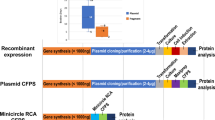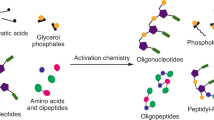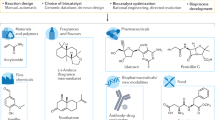Abstract
Using a system that accelerates the serendipitous discovery of new reactions by evaluating hundreds of DNA-encoded substrate combinations in a single experiment, we explored a broad range of reaction conditions for new bond-forming reactions. We discovered reactivity that led to a biomolecule-compatible, Ru(II)-catalysed azide-reduction reaction induced by visible light. In contrast to current azide-reduction methods, this reaction is highly chemoselective and is compatible with alcohols, phenols, acids, alkenes, alkynes, aldehydes, alkyl halides, alkyl mesylates and disulfides. The remarkable functional group compatibility and mild conditions of the reaction enabled the azide reduction of nucleic acid and oligosaccharide substrates, with no detectable occurrence of side reactions. The reaction was also performed in the presence of a protein enzyme without the loss of enzymatic activity, in contrast to two commonly used azide-reduction methods. The visible-light dependence of this reaction provides a means of photouncaging functional groups, such as amines and carboxylates, on biological macromolecules without using ultraviolet irradiation.
This is a preview of subscription content, access via your institution
Access options
Subscribe to this journal
Receive 12 print issues and online access
$259.00 per year
only $21.58 per issue
Buy this article
- Purchase on Springer Link
- Instant access to full article PDF
Prices may be subject to local taxes which are calculated during checkout




Similar content being viewed by others
References
Kanan, M. W., Rozenman, M. M., Sakurai, K., Snyder, T. M. & Liu, D. R. Reaction discovery enabled by DNA-templated synthesis and in vitro selection. Nature 431, 545–549 (2004).
Beeler, A. B., Su, S., Singleton, C. A. & Porco, J. A. Discovery of chemical reactions through multidimensional screening. J. Am. Chem. Soc. 129, 1413–1419 (2007).
Rozenman, M. M., Kanan, M. W. & Liu, D. R. Development and initial application of a hybridization-independent, DNA-encoded reaction discovery system compatible with organic solvents. J. Am. Chem. Soc. 129, 14933–14938 (2007).
Scriven, E. F. V. & Turnbull, K. Azides – their preparation and synthetic uses. Chem. Rev. 88, 297–368 (1988).
Johnstone, R. A. W., Wilby, A. H. & Entwistle, I. D. Heterogeneous catalytic transfer hydrogenation and its relation to other methods for reduction of organic compounds. Chem. Rev. 85, 129–170 (1985).
Bayley, H., Standring, D. N. & Knowles, J. R. Propane-1,3-dithiol – selective reagent for efficient reduction of alkyl and aryl azides to amines. Tetrahedron Lett. 19, 3633–3634 (1978).
Gololobov, Y. G. & Kasukhin, L. F. Recent advances in the Staudinger reaction. Tetrahedron 48, 1353–1406 (1992).
Burns, J. A., Butler, J. C., Moran, J. & Whitesides, G. M. Selective reduction of disulfides by tris(2-carboxyethyl)phosphine. J. Org. Chem. 56, 2648–2650 (1991).
Maryanoff, B. E. & Reitz, A. B. The Wittig olefination reaction and modifications involving phosphoryl-stabilized carbanions – stereochemistry, mechanism, and selected synthetic aspects. Chem. Rev. 89, 863–927 (1989).
Sakurai, K., Snyder, T. M. & Liu, D. R. DNA-templated functional group transformations enable sequence-programmed synthesis using small-molecule reagents. J. Am. Chem. Soc. 127, 1660–1661 (2005).
Agard, N. J., Baskin, J. M., Prescher, J. A., Lo, A. & Bertozzi, C. R. A comparative study of bioorthogonal reactions with azides. ACS Chem. Biol. 1, 644–648 (2006).
Brase, S., Gil, C., Knepper, K. & Zimmermann, V. Organic azides: an exploding diversity of a unique class of compounds. Angew. Chem. Int. Ed. 44, 5188–5240 (2005).
Kohn, M. & Breinbauer, R. The Staudinger ligation – a gift to chemical biology. Angew. Chem. Int. Ed. 43, 3106–3116 (2004).
Kolb, H. C. & Sharpless, K. B. The growing impact of click chemistry on drug discovery. Drug Discov. Today 8, 1128–1137 (2003).
Valeur, E. & Bradley, M. Amide bond formation: beyond the myth of coupling reagents. Chem. Soc. Rev. 38, 606–631 (2009).
Sletten, E. M. & Bertozzi, C. R. Bioorthogonal chemistry: fishing for selectivity in a sea of functionality. Angew. Chem. Int. Ed. 48, 6974–6998 (2009).
Hermanson, G. T. Bioconjugate Techniques. 2nd edn, 169–181 (Academic, 2008).
Basle, E., Joubert, N. & Pucheault, M. Protein chemical modification on endogenous amino acids. Chem. Biol. 17, 213–227 (2010).
Meldal, M. & Tornoe, C. W. Cu-catalyzed azide–alkyne cycloaddition. Chem. Rev. 108, 2952–3015 (2008).
Holmberg, A. et al. The biotin–streptavidin interaction can be reversibly broken using water at elevated temperatures. Electrophoresis 26, 501–510 (2005).
Solabannavar, S. B., Helavi, V. B., Desai, U. V. & Mane, R. B. A novel short synthesis of norbisabolide. Tetrahedron Lett. 43, 4535–4536 (2002).
Baciocchi, E., Dellaira, D. & Ruzziconi, R. Dimethyl arylmalonates from cerium(IV) ammonium-nitrate promoted reactions of dimethyl malonate with aromatic compounds in methanol. Tetrahedron Lett. 27, 2763–2766 (1986).
Poulsen, T. B. & Jorgensen, K. A. Catalytic asymmetric Friedel–Crafts alkylation reactions – copper showed the way. Chem. Rev. 108, 2903–2915 (2008).
Bandini, M., Melloni, A. & Umani-Ronchi, A. New catalytic approaches in the stereoselective Friedel–Crafts alkylation reaction. Angew. Chem. Int. Ed. 43, 550–556 (2004).
Scheiner, P., Schomake, J. H., Deming, S., Libbey, W. J. & Nowack, G. P. Addition of aryl azides to norbornene. A kinetic investigation. J. Am. Chem. Soc. 87, 306–311 (1965).
Zhdankin, V. V. & Stang, P. J. Chemistry of polyvalent iodine. Chem. Rev. 108, 5299–5358 (2008).
Juris, A. et al. Ru(II) polypyridine complexes: photophysics, photochemistry, electrochemistry, and chemiluminescence. Coord. Chem. Rev. 84, 85–277 (1988).
Kalyanasundaram, K. Photophysics, photochemistry and solar-energy conversion with tris(bipyridyl)ruthenium(II) and its analogs. Coord. Chem. Rev. 46, 159–244 (1982).
Nicewicz, D. A. & MacMillan, D. W. C. Merging photoredox catalysis with organocatalysis: The direct asymmetric alkylation of aldehydes. Science 322, 77–80 (2008).
Ischay, M. A., Anzovino, M. E., Du, J. & Yoon, T. P. Efficient visible light photocatalysis of [2+2] enone cycloadditions. J. Am. Chem. Soc. 130, 12886–12887 (2008).
Narayanam, J. M. R., Tucker, J. W. & Stephenson, C. R. J. Electron-transfer photoredox catalysis: development of a tin-free reductive dehalogenatioin reaction. J. Am. Chem. Soc. 131, 8756–8757 (2009).
Yoon, T. P., Ischay, M. A. & Du, J. N. Visible light photocatalysis as a greener approach to photochemical synthesis. Nature Chem. 2, 527–532 (2010).
Delaive, P. J., Sullivan, B. P., Meyer, T. J. & Whitten, D. G. Applications of light-induced electron-transfer reactions – coupling of hydrogen generation with photo-reduction of ruthenium(II) complexes by triethylamine. J. Am. Chem. Soc. 101, 4007–4008 (1979).
Su, W., Li, Y. S. & Zhang, Y. M. Samarium diiodide induced reductive coupling of nitriles with azides. J. Chem. Res. (S), 32–33 (2001).
Benati, L. et al. Radical reduction of aromatic azides to amines with triethylsilane. J. Org. Chem. 71, 5822–5825 (2006).
Hays, D. S. & Fu, G. C. Development of Bu3SnH-catalyzed processes: efficient reduction of azides to amines. J. Org. Chem. 63, 2796–2797 (1998).
Borak, J. B. & Falvey, D. E. A new photolabile protecting group for release of carboxylic acids by visible-light-induced direct and mediated electron transfer. J. Org. Chem. 74, 3894–3899 (2009).
Fancy, D. A. & Kodadek, T. Chemistry for the analysis of protein–protein interactions: rapid and efficient cross-linking triggered by long wavelength light. Proc. Natl Acad. Sci. USA 96, 6020–6024 (1999).
Gill, M. R. et al. A ruthenium(II) polypyridyl complex for direct imaging of DNA structure in living cells. Nature Chem. 1, 662–667 (2009).
Raines, R. T. Ribonuclease A. Chem. Rev. 98, 1045–1065 (1998).
Lee, H. M., Larson, D. R. & Lawrence, D. S. Illuminating the chemistry of life: design, synthesis, and applications of ‘caged’ and related photoresponsive compounds. ACS Chem. Biol. 4, 409–427 (2009).
Mayer, G. & Heckel, A. Biologically active molecules with a ‘light switch’. Angew. Chem. Int. Ed. 45, 4900–4921 (2006).
Sinha, R. P. & Hader, D. P. UV-induced DNA damage and repair: a review. Photochem. Photobiol. Sci. 1, 225–236 (2002).
Griffin, R. J. et al. The 4-azidoberazyloxycarbonyl function; application as a novel protecting group and potential prodrug modification for amines. J. Chem. Soc. Perkin Trans. 1, 1205–1211 (1996).
Wuts, P. G. M. & Greene, T. W. Greene's Protective Groups in Organic Synthesis. 4th edn, 533–646 (Wiley, 2007).
Crook, E. M., Mathias, A. P. & Rabin, B. R. Spectrophotometric assay of bovine pancreatic ribonuclease by the use of cytidine 2′-3′-phosphate. Biochem. J. 74, 234–238 (1960).
Acknowledgements
This work was supported by NIH grant R01GM065865 and the Howard Hughes Medical Institute. We thank Y. Shen and C. Dumelin for MS assistance, and D. Gorin for discussions.
Author information
Authors and Affiliations
Contributions
Y.C., A.S.K., J.B.S. and D.R.L. designed the research, analysed the data and co-wrote the manuscript, Y.C., A.S.K. and J.B.S. performed the experiments.
Corresponding author
Ethics declarations
Competing interests
The authors declare no competing financial interests.
Supplementary information
Supplementary information
Supplementary information (PDF 6471 kb)
Rights and permissions
About this article
Cite this article
Chen, Y., Kamlet, A., Steinman, J. et al. A biomolecule-compatible visible-light-induced azide reduction from a DNA-encoded reaction-discovery system. Nature Chem 3, 146–153 (2011). https://doi.org/10.1038/nchem.932
Received:
Accepted:
Published:
Issue Date:
DOI: https://doi.org/10.1038/nchem.932
This article is cited by
-
Bioorthogonal photocatalytic proximity labeling in primary living samples
Nature Communications (2024)
-
Targeted activation in localized protein environments via deep red photoredox catalysis
Nature Chemistry (2023)
-
Strategies for developing DNA-encoded libraries beyond binding assays
Nature Chemistry (2022)
-
Cleaving arene rings for acyclic alkenylnitrile synthesis
Nature (2021)
-
Light-driven post-translational installation of reactive protein side chains
Nature (2020)



